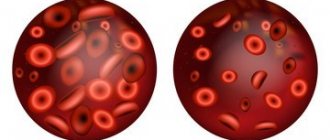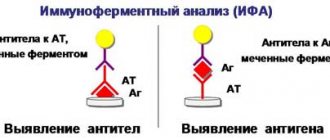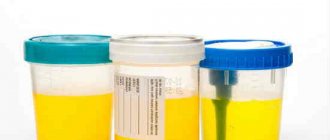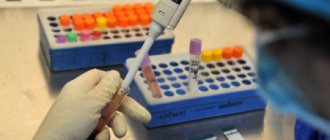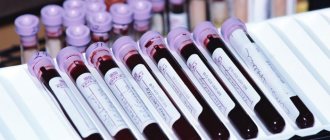Function of iron in the blood
Blood is the main element in the human body, which is entrusted with the largest number of functions and responsibilities. Blood provides cells with nutrients, removes metabolic end products, participates in thermoregulation, and is a connecting link between all human organs.
However, its most important function is to saturate each cell with oxygen, without which their life and normal functioning are impossible. And it is in this process that serum iron is involved.
In addition, iron ensures the process of hematopoiesis, normal cell activity, regulates immunobiological processes and redox reactions.
Iron is not found in the blood in its pure form, but is part of hemoglobin, myoglobin, cytochromes, and myeloenzymes. A certain amount of it is found in the spleen, liver and bone marrow in the form of a so-called reserve. And up to 80% of the total volume of iron is part of hemoglobin. It is precisely as part of the latter that it is responsible for hematopoiesis, saturation of cells with oxygen and regulation of the immune system.
Iron levels are directly affected by a person's diet.
This is mainly beef, liver, buckwheat, legumes and eggs. In addition to those containing iron, you need to consume foods containing vitamin C, which promotes the absorption of iron.
Blood test
Iron levels can change throughout the day, with the highest concentrations in the morning. It also depends on the gender of the person, with men having a higher level. In women, its content is lower, often depending on the menstrual cycle. Also, its indicator is directly affected by stress, fatigue and lack of adequate sleep.
The normal level of content in men is fixed in the range from 11.64 to 30.43, in women - 8.95-30.43 µmol/liter. For children under one year old and from one year to 14 years old, this figure is 7.16-17.90 and 8.95-21.48, respectively.
The iron content in the blood is checked through a biochemical analysis of venous blood. It is recommended to collect blood for analysis in the morning, on an empty stomach, preferably between 7 and 10 hours. The correctness of the result can be affected by even one iron-containing tablet taken the day before, testosterone or aspirin in large doses, the use of vitamin B12, contraceptives in tablets and alcohol.
This blood test is prescribed if a person experiences severe fatigue, depression, general weakness, lack of appetite, disruption of the gastrointestinal tract, dry and pale skin, and disruption of the immune system. In addition, brittle hair and nails, cracks in the corners of the mouth, impaired taste and smell, and increased temperature are observed.
Reasons for changing the indicator
Low iron levels in a person’s blood depend on many factors, both external and internal. First of all, this is an unbalanced diet, a poor diet, and vegetarianism. It’s not for nothing that they say: we are what we eat. For normal life, people must consume with food all the fats, proteins, carbohydrates, vitamins they need, and most importantly, iron.
Beef and liver are the main iron-containing foods available to humanity.
Their deficiency or refusal to eat should be replaced with other products that can saturate the body with iron. These can be beans, apples, fish oil, fresh herbs.
In addition, there are a number of internal diseases that result in low iron in the blood.
Since the entry of this element occurs mainly through the digestive system, namely the duodenum, its low level may be due to various diseases of this area. Any inflammatory process in the intestines can reduce the absorption of beneficial microelements, and as a result, there is a lack of iron.
With intensive growth in adolescents and children, the level of iron in the blood decreases sharply, as a result, reserves of this element are borrowed from the liver and bone marrow, which leads to general exhaustion.
Decreased performance
When an iron blood test reveals low iron levels in the blood, this may indicate the following conditions, disorders and diseases:
- vitamin B12 deficiency;
- high body need for iron (growth period, pregnancy and lactation);
- infectious diseases;
- Iron-deficiency anemia;
- chronic renal failure;
- acute and chronic bleeding;
- hypothyroidism (dysfunction of the thyroid gland);
- blood diseases;
- chronic viral hepatitis;
- cirrhosis of the liver.
To treat iron deficiency, it is necessary to normalize the diet, take iron-containing drugs and nutritional supplements, B vitamins and ascorbic acid. If the iron content is high, a special diet is used that limits the consumption of foods high in iron, alcohol and fruits rich in vitamin C. Blood transfusions are also used as treatment.
Consequences
The main and most common consequence of a lack of iron in the blood is anemia. This blood disease is directly related to the level of hemoglobin, in other words, red blood cells. They transport oxygen and important microelements throughout the body. Anemia in children is often caused by consuming large amounts of dairy products, which interfere with iron absorption and accelerated growth. The main symptoms of anemia are fatigue, headache, lethargy, and dizziness. If anemia is not diagnosed in time in children and the elderly, it can even lead to death.
Another very dangerous consequence of iron deficiency is a weakened immune system.
In this case, the blood serum loses the ability to promptly inform certain organs about disturbances in their work, which leads to the body’s inability to resist infections. This can lead to the development of chronic respiratory diseases, tuberculosis, and shortness of breath.
Lack of iron can cause a decrease in blood pressure, which leads to frequent dizziness, weakness, muscle atrophy and heart rhythm disturbances.
How to increase serum iron in the blood
If, after a biochemical blood test, a lack of iron in the blood is detected, the attending physician must conduct a detailed examination of the patient, interview him, and, if necessary, prescribe additional tests. It is important to make an accurate diagnosis in time and carry out timely treatment so that irreversible processes do not occur in the body as a whole and in organs in particular.
If your iron level is low due to an incorrect and unbalanced diet, you should think about your diet, take iron-containing tablets, and exclude dairy products from your diet.
If it turns out that the problem is in the intestines, it is very important to localize the disease and eliminate it and its consequences. In general, conventional drug treatment is sufficient; in extreme cases, surgical intervention is used.
It is very important to monitor both iron and hemoglobin levels in preschool children, adolescents and the elderly. This category should regularly undergo blood tests for timely diagnosis of anemia and other diseases. In children, due to their active growth, a lack of oxygen can lead to quite complex deviations, developmental delays, and growth retardation. When the level of this microelement decreases, it is necessary to include liver, apples, nuts in their diet, reduce the amount of dairy products, but not exclude them completely, since they are the main sources of calcium necessary for the formation and growth of bone mass.
In elderly people with limited health and activity, even if iron levels are slightly reduced, this can lead to irreparable changes in the brain and heart muscle.
The same can be said about pregnant women. The consumption of iron-containing products in this category of the population should be doubled, and monitoring of its indicators should be carried out quite regularly. As in other cases, you should eat right, take prenatal vitamins, and constantly visit your doctor.
With a normal lifestyle, a balanced diet, exclusion of alcohol and other harmful substances, and careful monitoring of your condition, the complete absorption of iron and its accumulation in the body are guaranteed.
Biochemical analysis of iron in the blood
Iron is one of the most important components of blood, which is a necessary component of hemoglobin and is directly involved in the process of hematopoiesis. A sufficient level of iron in the body is necessary to ensure the process of binding, transporting and transmitting oxygen during blood circulation. Iron enters our body with food, and after absorption in the intestines it is distributed through the blood vessels. Iron reserves in the body are deposited in the liver, bone marrow and spleen.
To maintain optimal levels of iron in the blood, you need to regularly consume foods rich in this microelement: meat and liver, fish, milk, eggs, soybeans, beans, peas, buckwheat, oatmeal and millet porridge, pomegranates, walnuts. The female body's need for iron is almost twice as high as that of the male body. This is due to menstruation, during which a woman’s body loses a significant amount of iron. During pregnancy and breastfeeding, a woman’s need for iron increases by one and a half times. A growing child's body also needs an increased supply of iron.
Lack or excess of iron is detected using biochemical analysis. These disorders can have very serious consequences for the body, especially if they are chronic. Let's consider in what cases a biochemical blood test for iron is prescribed, what are the norms of iron in a blood test, and also for what reasons iron deficiency or excess occurs.
Types of iron in the body
Iron in the body can be classified depending on the functions it performs and where it is located:
- The functions of cellular iron are to transport oxygen;
- The functions of extracellular serum, which includes Fe-binding serum proteins - transferrin and lactoferrin - as well as free plasma iron, are responsible for the amount of hemoglobin;
- The reserve fund - or reserves - is hemosiderin and ferritin, protein compounds that, accumulating in the liver and spleen, are responsible for red blood cells so that they are always viable.
With a biochemical blood test - it is taken from a vein - which is carried out to determine the amount of iron in the serum, and a hemoglobin test - in this case you have to prick your finger - the condition of the whole organism is determined.
These indicators change during acute inflammatory processes, regardless of their etiology. They are also necessary to identify errors in nutrition and determine the degree of intoxication. Disruption of metabolic processes in the body, excess or decrease in the amount of nutrients necessary for normal life - indicators of these conditions are indicators of iron and hemoglobin.
Indications for analysis
For analysis, blood is drawn from a vein. An iron blood test is prescribed in the following cases:
- if poisoning with iron-containing products is suspected and to identify irregularities in the diet;
- for diagnosing various types of anemia;
- for the diagnosis of acute and chronic infectious diseases;
- with hypo- and vitamin deficiency;
- in case of disorders of the gastrointestinal tract;
- to assess the effectiveness of the therapy.
The highest level of iron in a biochemical blood test is observed in the morning, therefore, to obtain reliable results, the study must be carried out in the morning. Blood is donated on an empty stomach, abstaining from eating for 8–12 hours before the test. For the biochemical analysis of iron in the blood, the colorimetric method is usually used. It accurately detects the level of iron content and is also simple to implement.
Data
- a test for iron in the blood is carried out to diagnose iron deficiency anemia; transferrin-bound Fe3+ is determined
- The liver hormone hepcidin is responsible for the exchange of iron in the body.
- the body is unable to get rid of excess iron, only absorption and distribution are regulated
- the consequences of excess iron are cirrhosis of the liver, fibrosis of the pancreas and brown discoloration of the skin - bronze diabetes
- anemia due to iron deficiency - hypochromic, microcytic, which means that the red blood cells are smaller and contain little hemoglobin
- Excess iron occurs in lead poisoning
Serum iron analysis was last modified: January 27th, 2018 by Maria Bodyan
Norms
The iron content in the human body depends on gender, age and weight.
The iron level in a blood test for men varies from 11.64 to 30.43 µmol/l. For women, the normal level of iron in a blood test is 8.95–30.43 µmol/l. In children under 12 months of age, the iron level in the body should be 7.17–17.90 µmol/l, and in children under 14 years of age – 8.95–21.28 µmol/l. Low iron levels in the blood lead to symptoms such as fatigue, depression, feeling weak, decreased immunity, muscle weakness, lack of appetite, indigestion, shortness of breath, pale and dry skin. Long-term lack of iron leads to the development of iron deficiency anemia. In children, iron deficiency affects growth retardation and developmental disorders.
High levels of iron in the blood over a long period of time also have serious consequences. Iron begins to be deposited in tissues and organs, the ability of the intestines to regulate iron metabolism in the body is disrupted, which leads to disruption of the functioning of internal organs. If this condition lasts for a long time, it can lead to the development of diabetes, heart and liver disease, rheumatoid arthritis and even breast cancer.
Norm, µmol/l
- newborns - 11.0 - 36.0
- children from 1 month to 1 year – 6.0 – 28.0
- children 1-15 years old - 4.0 - 24.0
- men - 7.2 - 29.0
- women - 6.6 - 28.0
Remember that each laboratory, or rather laboratory equipment and reagents, has its own standards. In the laboratory test form they appear in the column - reference values or norm.
Increased performance
If a blood test for iron shows an increased concentration of this trace element in the blood, this may indicate the presence of the following disorders and diseases:
- deficiency of vitamins B6, B12 and folic acid;
- poisoning from food additives or preparations containing iron;
- lead poisoning;
- hypoplastic, pernicious or hemolytic anemia;
- hemochromatosis (disturbance in the process of removing iron from the body);
- leukemia;
- thalassemia;
- nephritis;
- acute or chronic viral hepatitis.
Elevated iron levels can also be detected with regular use of estrogens or oral contraceptives.
A test for iron in the blood is carried out together with the following studies
- General blood test - special attention to hemoglobin, red blood cells, red blood cell indices - MCH, MCHC, MCV
- reticulocyte test
- ferritin
- total iron binding capacity of serum - TIBC
- soluble transferrin receptors
- vitamin B12 – cyanocobalamin
- folic acid
- transferrin
- erythropoietin
- liver tests
- kidney tests
- thyroid hormone test
- C-peptide
- alpha amylase

